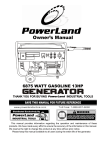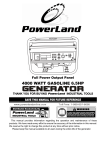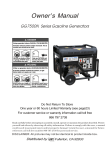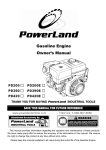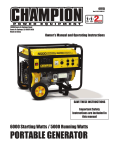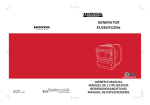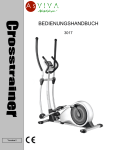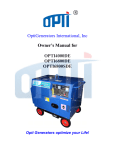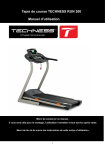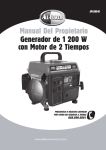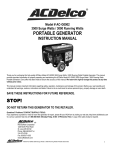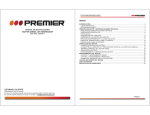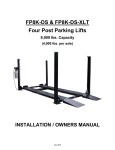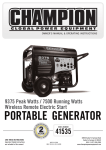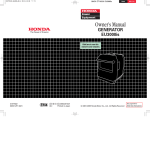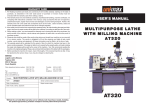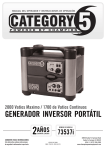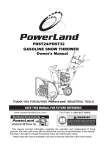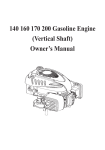Download to user manual
Transcript
Owner’s Manual Full Power Output Panel SERIES GASOLINE, LPG, NG POWER This manual provides information regarding the operation and maintenance of these products. We have made every effort to ensure the accuracy of the information in this manual. We reserve the right to change this product at any time without prior notice. Please keep this manual available to all users during the entire life of the GASOLINE, LPG, NG generator. Engine Generator SPECIFICATIONS Item Rated Wattage Surge Wattage Rated Voltage Rated Frequency Phase DC Output Engine type Ignition system Spark Plug Engine Speed Compression Ratio Displacement Starting type Fuel Oil capacity Engine oil grade Valve Clearance Noise Level Dimensions (in): PD3G4400E 3500 W 4400 W PD3G6500E PD3G8500E PD3G10000E 5500 W 7000 W 8000 W 6500 W 8500 W 10000 W 120/240 V 60 Hz Single DC 12V/8.3 A 4-stroke OHV single cylinder with forced air cooling system Transistorized magneto NGK BPR6ES, F7RTC 3600 rpm 8.5 : 1 8.0 : 1 208 cc 419 cc Electric start /Recoil Use clean, fresh, regular LPG with LPG gas pressure area: 10~15 PSI. Use clean, fresh, regular Natural Gas with NG gas pressure area: 0.25 PSI. Use gasoline with a pump octane rating of 86 or higher 0.63 US qt 1.2 US qt (1.1 L) (0.6 L) SAE 10W30 SG or SF or SN Intake 0.10-0.15 mm (0.004 – 0.006 in.) Exhaust 0.15-0.20 mm (0.006 – 0.008 in.) 75 dB @ 7 m (22 feet) 28"×21.6"× 30.3"X28.7"X 30.2"×22.5"×24.2" 22.6" 25.2" The engine exhaust from this product contains chemicals known to the State of California to cause cancer, birth defects or other reproductive harm. WARNING: The generator is a potential source of electrical shock if misused. Do not expose the generator to moisture, rain or snow. Do not let the generator get wet, and do not operate it with wet hands. Keep this owner's manual handy, so you can refer to it at any time. This owner’s manual is considered a permanent part of the generator and should remain with the generator if resold. Congratulations on your selection of our generator. We are certain you will be pleased with your purchase of one of the finest generators on the market. We want to help you get the best results from your new generator and to operate it safely. This manual contains the information on how to do that, please read it carefully. As you read this manual, you will find information preceded by a symbol. That information is intended to help you avoid damage to your generator, other property, or the environment. When your generator needs scheduled maintenance, keep in mind that our servicing dealer is specially trained in servicing our generators. Your authorized our servicing dealer is dedicated to your satisfaction and will be pleased to answer your questions and concerns. A FEW WORDS ABOUT SAFETY Your safety and the safety of others is very important. And using this generator safely is an important responsibility. To help you make informed decisions about safety, we have provided operating procedures and other information on labels and in this manual. This information alerts you to potential hazards that could hurt you or others. Of course, it is not practical or possible to warn you about all the hazards associated with operating or maintaining a generator. You must use your own good judgment. You will find important safety information in a variety of forms, including; ·Safety Labels — on the generator. ·Safety Messages — Preceded by a safety alert symbol and one of three signal words, DANGER, WARNING, or CAUTION. These signal words mean: DANGER: You WILL be KILLED or SERIOUSLY HURT if you don't follow instructions. WARNING: You WILL be KILLED or SERIOUSLY HURT if you don't follow instructions. CAUTION: You CAN be HURT if you don't follow instructions. ·Safety Headings — such as IMPORTANT SAFETY INFORMATION. ·Safety Section — such as GENERTOR SAPETY. ·Instructions — how to use this generator correctly and safely. This entire book is filled with important safety information — please read it carefully. CONTENTS SAFETY ........................……………………………………………………………………........ 1 Safety Label Locations ...................... …………………………………………………..........1 Safety Information ............................ …………………………………………………………....1 COMPONENT IDENTIFICATION ......................…………………………………………………3 CONTROLS ..................…………………………………………………………………………..4 Engine Switch ................………………………………………………………………………..4 Recoil Starter ………………………………………………………....................... …….........…4 Fuel Valve Lever ……………………………………………………………………………………4 Choke Rod ..…………………………………………………………………………………..... 5 Voltage Selector Switch (Dual Voltage System) ............... ……………………….............. 5 Ground Terminal ................................................................................ ………….............. 6 DC Terminal ........................................................................................ …………..............6 DC Circuit Protector ...............……………………………………………………………………..6 Oil Alert System ................... ……………………………………………………………..........6 AC Circuit Breaker.... ………………………………………………………………………………7 AC Circuit Protector…………………………………………………………………………………8 Auto Throttle System…………………………………………………………………………………8 GENERATOR USE ................................…………………………………………………………9 Connections to a Building Electrical System..........................…………………………………9 Ground System ................................................................................... ………………………9 AC Applications .................................................................................. ………………………9 AC Operation ...................................................................................... ………………………9 AC Receptacle Selection .................................................................... ……………………… 10 DC Operation ...................................................................................... ……………………… 11 PRE-OPERATION CHECK........................... …………………………………………………12 Engine Oil ................................ …………………………………………………………………12 Fuel Recommendation ................................ …………………………………………………13 STARTING THE ENGINE/STOPPING THE ENGINE .............. ………………….................17 MAINTENANCE ................................ ……………………………………………………………19 The Importance of Maintenance ................................ ………………………………………19 Maintenance Safety ................................ ………………………………………………………20 Emission Control System Information ................................ …………………………………20 Air Index ........................................................ ………………………………………...............22 Maintenance Schedule ................................ …………………………………………………22 Engine Oil Change ................................ ………………………………………………………23 Air Cleaner Service ................................………………………………………………………23 Fuel Sediment Cup Cleaning ..............................………………………………………………24 Spark Plug Service ................................ ………………………………………………………24 Spark Arrester Maintenance................... ………………………………………………………25 TRANSPORTING/STORAGE............ ……………………………………………………………26 ASSEMBLY....…………………………………………………………………………………………28 TROUBLESHOOTING...............................…………………………………………………………29 Grounding Requirements for Power Land Portable Generators…………………………………31 WIRING DIAGRAM ................................ …………………………………………………………34 EXPLODED VIEW AND PARTS LIST....... …………………………………………………………38 SAFETY SAFETY INFORMATION Our generators are designed to give safe and dependable service if operated according to instructions. Reed and understand this owner's manual before operating your generator. You can help prevent accidents by being familiar with your generator's controls, and by observing safe operating procedures. Operator Responsibility ·Know how to stop the generator quickly in case of emergency. ·Understand the use of all generator controls, output receptacles, and connections. ·Be sure that anyone who operates the generator receives proper instruction. Do not let children operate the generator without parental supervision. Carbon Monoxide Hazards ·Exhaust contains poisonous carbon monoxide, a colorless and odorless gas. Breathing exhaust can cause loss of consciousness and may lead to death. ·If you run the generator in an area that is confined, or even partially enclosed, the air you breathe could contain a dangerous amount of exhaust gas. To keep exhaust gas from building up, provide adequate ventilation. Electric Shock Hazards ·The generator produces enough electric power to cause a serious shock or electrocution if misused. ·Using a generator or electrical appliance in wet conditions, such as rain or snow, or near a pool or sprinkler system, or when your hands are wet, could result in electrocution. Keep the generator dry. ·If the generator is stored outdoors, unprotected from the weather, check all electrical components on the control panel, before each use. Moisture or ice can cause a malfunction or short circuit in electrical components which could result in electrocution. ·Do not connect to a building's electrical system unless an isolation switch has been installed by a qualified electrician. 1 Fire and Burn Hazards ·The exhaust system gets hot enough to ignite some materials. — Keep the generator at least 1 meter (3 feet) away from buildings and other equipment during operation. — Do not enclose the generator in any structure. — Keep flammable materials away from the generator. ·The muffler becomes very hot during operation and remains hot for a while after stopping the engine. Be careful not to touch the muffler while it is hot. Let the engine cool before storing the generator indoors. ·Gasoline is extremely flammable and is explosive under certain conditions. Do not smoke or allow flames or sparks where the generator is refueled or where gasoline is stored. Refuel in a well-ventilated area with the engine stopped. ·Fuel vapors are extremely flammable and may ignite after the engine has started. Make sure that any spilled fuel has been wiped up before starting the generator. ·Always keep fuel away from sparks, open flames, pilot lights, heat and other sources of ignition. · DO NOT light or smoke cigarettes. WARNING: When use the LPG generator, if find any problems(LPG leakage or strange smells), please turn off the gas source immediately and then check the connection hose to insure the safely. WARNING: 1. When using the LPG/Gasoline generator, please be sure that there is at least 5 feet distance between LGP tank connecting hose and the generator, to prevent unnecessary danger because of high temperature surface of LGP tank. 2. When using the unit, please check the surface temperature of LPG tank. 3. Don't place the LPG tank in one place where ambient temperature above 35℃ and use LPG for electricity generating. 2 COMPONENT IDENTIFICATION Record the engine and frame serial numbers for your future reference. Refer to these serial numbers when ordering parts, and when making technical or warranty inquiries. 3 CONTROLS Engine Switch To start and stop the engine Switch position: OFF: To stop the engine. Key can be removed/inserted. ON: To run the engine after starting. START: To start the engine by operating the starter motor. OFF OFF ON START ENGINE SWITCH ENGINE SW ITCH ON ON OFF OFF Recoil Starter Turn engine switch to “ON” To start the engine, pull the starter grip lightly until resistance is felt, then pull briskly. NOTICE: Do not allow the starter grip to snap back against the engine. Return it gently to prevent damage to the starter. The recoil starter is used to start the engine if the generator is not equipped with a 12 volt battery to operate the starter motor, or if the battery does not contain adequate charge to operate the starter motor. FUEL VALVE LEVER Fuel Valve Lever The fuel valve is located between the fuel tank and carburetor. When the fuel valve lever is in the ON position, fuel is allowed to flow from the fuel tank to the carburetor. Be sure to return the fuel lever to the OFF position after stopping the engine. FUEL VALVE LEVER OFF OFF ON ON 4 Choke Rod The choke is used to provide an enriched fuel mixture when starting a cold engine. It can be opened and closed by operating the choke lever manually. Move the choke lever or pull the choke rod out to the CLOSED position to enrich the mixture for cold starting. Voltage Selector Switch The voltage selector switches the main power carrying windings of the generator to produce "120V ONLY" or "120/240V". If a 240V appliance is connected to the 4-prong receptacle, the switch must be in the "120/240V" position. If only a 120V appliance is being connected to any of the 120V 3-prong receptacles, select the "120V ONLY" position. 120/240V: The 120V and 120/240V receptacles can be used simultaneously. 120V Receptacles only can output half of the rated power. 120V ONLY: ONLY the 120V receptacles can be used. Do not use the 120/240V receptacle in this position. Rated power will be available at the 120V twist lock receptacle. The most power will be available at the 30A 120V locking plug receptacle. WARNING:Change the Voltage Selector Switch after turning the AC circuit breaker to OFF. The generator may be damaged. 5 120/240V 120V ONLY Before using the ground terminal, consult a qualified electrician, electrical inspector or local agency having jurisdiction for local codes or ordinances that apply to the intended use of the generator. 120V ONLY 120/240V DC Terminals VOLTAGE SELECTOR SWITCH The DC terminals may ONLY be used for charging 12 volt automotive type batteries. GROUND TERMINAL The terminals are colored, red will identify the positive (+) terminal and black will identify the negative (-) terminal. The battery must be connected to the generator DC terminals with the proper polarity (battery positive must be connected to the generator red terminal and battery negative must be connected to the generator black terminal). DC CIRCUIT PROTECTOR ON DC CIRCUIT PROTECTOR ON OFF OFF NEGATIVE TERMINAL (BLACK) NEGATIVE TERMINAL (BLACK) POSITIVE TERMINAL (RED) POSITIVE TERMINAL (RED) DC Circuit Protector The DC circuit protector automatically shuts off the DC battery charging circuit when the DC charging circuit is overloaded, when there is a problem with the battery, or when the connections between the battery and the generator are improper. Oil Alert System The Oil Alert System is designed to prevent engine damage caused by an insufficient of oil in the crankcase. Before the oil level in the crankcase can fall below a safety limit, the oil alert system will automatically stop the engine (the engine switch will remain in the ON position). If the engine stops and will not restart, check the engine oil level before troubleshooting in other areas. 6 Auto Throttle System The auto throttle system automatically reduces engine speed when all loads (i.e.: tools and appliances) are turned off or disconnected. When loads are turned on or reconnected, the engine returns to the rated speed. Switch Position ON: Recommended to minimize fuel consumption and further reduce noise levels when no load is applied to the generator. The auto throttle system does not operate. OFF: Recommended to minimize warm-up time when the generator is started and starting load with large start-up power equipments. *NOTICE: If connect to a residence, it is recommended that the auto throttle be kept in the “ON” position if less than 50% load is being used. If the generator will be running over 50% it is recommended that you switch to the “OFF” position. AUTO THROTTLE SWITCH ON OFF AC Circuit Breaker The circuit breaker must be in the “ON” position in order to start running a load, but it will automatically switch “OFF” if there is a short circuit or a significant overload of the generator at the receptacle. If the circuit breaker is switched OFF automatically, check that the appliance is working properly and does not exceed the rated load capacity of the circuit before switching the circuit breaker ON again. *The circuit breaker may be used to switch the generator power ON or OFF. PD3G4400E PD3G10000E AC CIRCUIT BREAKER ON OFF 7 AC Circuit Protector PD3G8500E The AC circuit protectors will automatically switch OFF if there is a short circuit or a significant overload of the generator at the 20A 120V, 30A 120V locking plug, or 120/240V locking plug receptacle. If a AC circuit protector switches OFF automatically, check that the appliance is working properly and does not exceed the rated load capacity of the circuit before resetting the AC circuit protector ON. Gas Denser Device To develop cold start performance of LPG/NG generator unit, the air REDUCER ASSY includes one gas denser device lever, the detailed operation of the bottom is as below. Choose the connector according to the gas you use: ● If you use LPG, you need to put the LPG hose to the LPG inlet, make the NG inlet screw and seal well with the nut and turn the LPG/NG selector switch to LPG position. ● If you use NG, you need to put the NG hose to the NG inlet, make the LPG inlet screw and seal well with the nut and turn the LPG/NG selector switch to the NG position. When start the cold LPG/NG generator unit, open the valve of LPG tank or NG source, close the resistance air valve handle, push the gas denser device lever lightly, and keep 1-2 seconds, then stop, and then start the engine normally. CAUTION: Improper treatment or use of the generator can damage it, shorten its life and void your warranty ● The gas denser device lever only does work after turning on the gas source valve, if start normally, no need pull the lever, otherwise it will cause generator unit work abnormally; ● When push the gas denser device lever, the keeping time must not over 2 seconds, otherwise it is not good for start; No need to push the gas denser device lever at every start, only need to use when the first start of the cold generator unit or when need to change Gas; ● If with abnormality, please contact us; ● Prohibit adjusting the LPG gas-pressure adjusting screw and gas flow adjusting screw. 8 GENERATOR USE Connections to a Building Electrical System Connections for standby power to a building electrical system must be made by a qualified electrician. The connection must isolate the generator power from utility power, and must comply with all applicable laws and electrical codes. WARNING: Improper connections to a building electrical system will allow electrical current from the generator to back feed into the utility lines. Such back feed will electrocute utility company workers or others who contact the lines during a power outage, and the generator may explode, burn, or cause fires when utility power is restored. Consult the utility company or a qualified electrician. Ground System Generators have a system circuit that connects generator frame components to the ground terminals in the AC output receptacles. The system circuit is not connected to the AC neutral wire. If the generator is tested by a receptacle tester, it will show the same ground circuit condition as for a home receptacle. AC Applications Before connecting an appliance or power cord to the generator: • Make sure that it is in good working order. Faulty appliances or power cords can become hazardous and cause electrocution. • If an appliance begins to operate abnormally, operates sluggish or stops suddenly, turn it off immediately. Disconnect the appliance, and determine whether the problem is the appliance, or if the rated load capacity of the generator has been exceeded. • Make sure that the electrical rating of the tool or appliance does not exceed that of the generator. Never exceed the maximum power rating of the generator. Power levels between rated and maximum may be used for no more than 30 minutes NOTICE: Substantial overloading will open the circuit breaker. Exceeding the time limit for maximum power operation or slightly overloading the generator may not switch the circuit breaker or circuit protector OFF, but will shorten the service life of the generator. Limit operation requiring maximum power to 30 minutes. For continuous operation (longer than 30 minutes), do not exceed the rated power. The total power requirements (kW) of all appliances connected must be considered. Appliance and power tool manufacturers usually list rating information near the model number or serial number. AC Operation 1. Start the engine. 2. Turn the voltage selector switch to either position. 9 With the voltage selector switch in the ‘‘120/240V’’ position, you can use the 120V and 120/240V receptacles simultaneously. If you are NOT using the 120/240V receptacle, but require more power from the 120V locking plug receptacle, then select the ‘‘120V ONLY’’ position. 3. Switch the AC circuit breaker ON. 4. Plug in the appliance. Most motorized appliances require more than their rated power for startup. Do not exceed the current limit specified for any one receptacle. If an overloaded circuit causes the AC circuit breaker or AC circuit protector to switch OFF, reduce the electrical load on the circuit, wait a few minutes and then reset the AC circuit breaker or AC circuit protector. AC Receptacle Selection The generator has two separate main power producing circuits. These two circuits supply equal power to different receptacles shown when the voltage selector switch is in the 120/240V position. When two or more receptacles are used; to prevent overloading, dividing the load between the two power circuits. Example: The chart below shows the rated load in amperes that can be connected to each receptacle to balance the generator. For Example, we have one model of generator whose total rated ampere draws 65 A. Main Circuit I Receptacles powered by each main circuit 2, 4 and 6 Main Circuit II 1, 3 and 5 Main power circuit Power distribution 2+4+6=32.5 A rated. 1+3+5=32.5 A rated. The table shows the specifications when the 120/240V locking plug receptacle is used for 120V. Receptacle 1 has a 20A load connected to it. Receptacle 3 has a 15 A load connected to it. Both receptacles are powered by main power circuit II. The equation tells us that the total power draw on circuit II is 35A. This is a substantial overload of this circuit. To eliminate the excess power draw on circuit II, the load from receptacle 3 should be switched to receptacle 2. Now circuit I is powering the 20A load (less than 32.5A) and circuit II is powering a 15A load (less than 32.5A). 10 DC Operation The DC terminals may ONLY be used for charging 12 volt automotive type batteries. Connecting the battery cables: 1. Before connecting the battery charging cables to a battery that is installed in a vehicle battery, disconnect the vehicle ground battery cable from the battery negative (-) terminal. WARNING: The battery gives off explosive gases; keep sparks, flames and cigarettes away. Provide adequate ventilation when charging or using DC CIRCUIT batteries. ON PROTECTOR Battery posts, terminals and related accessories contain lead and lead compounds. Wash hands after handling. OFF 2. Connect the positive (+) battery cable to the automotive battery positive (+) terminal. NEGATIVE TERMINAL (BLACK) POSITIVE TERMINAL (RED) 3. Connect the negative (-) battery cable to the automotive battery negative (-) terminal. 4. Make sure circuit breaker is off. 5. Start the generator. NOTICE: Do not start the vehicle while the battery charging cable is connected and the generator is running. The vehicle or the generator may be damaged. An overloaded DC circuit, excessive current draw by the battery, or a wiring problem will trip the DC circuit protector (PUSH button extends out). If this happens, wait a few minutes before pushing in the circuit protector to resume operation. If the DC circuit protector continues to go OFF, discontinue charging and see your authorized generator dealer. Disconnecting the battery cables: 1. Stop the engine. 2. Disconnect the negative (-) battery cable from battery. 3. Disconnect the positive (+) battery cable from battery. Auto Throttle System With the switch in the ON position, engine speed is automatically reduced when ALL loads are turned OFF or disconnected. When appliances are turned ON or reconnected, the engine returns to rated speed. In the OFF position, the auto throttle system does not operate. 11 Appliances with large start-up power demands may not allow the engine to reach normal operating rpm when they are connected to the generator. Push the auto throttle switch to the OFF position and connect the appliance to the generator. If the engine still will not reach normal operating speed, check that the appliance does not exceed the rated load capacity of the generator. AUTO TH ROTTLE SWITCH ON OFF ON To avoid extended warm-up periods, keep the switch OFF until the engine reaches operating temperature. OFF The auto throttle system is not effective for use with appliances that require only momentary power. If the tool or appliance will be turned ON and OFF quickly, the auto throttle switch should be in the OFF position. PRE-OPERATION CHECK Engine oil NOTICE: Engine oil is major affecting engine performance and service life. Non-detergent and 2-stroke engine oils will damage the engine and are not recommended. Check the oil level BEFORE EACH USE with the generator on a level surface with the engine stopped. SAE Viscosity Grades AMBIENT TEMPERATURE Use 4-stroke motor oil that meets or exceeds the requirements for API service classification SJ or SG or SF or SN. Always check the API SERVICE label on the oil container to be sure it includes the letters SJ for SG or SF or SN. SAE 10W-30 is recommended for general, all-temperature use. Other viscosities shown in the chart may be used when the average temperature in your area is within the indicated range. 1. Remove the oil filler cap and wipe the dipstick clean. 2. Check the oil level by inserting the dipstick into the filler neck without screwing it in. 3. If the oil level is low, fill to the top of the oil filler neck with the recommended oil. 12 OIL FILLER HOLE OIL FILLER CAP UPPER LEVEL Fill Fuel in tank 1. Check the fuel level gauge, and refill the tank if the fuel level is low. 2. Refuel carefully to avoid spilling fuel. Do not fill above the shoulder of the fuel strainer. WARNING: Gasoline is highly flammable and explosive, and you can be burned or seriously injured when refueling, if refueling is not done without caution. • Stop engine and keep heat, sparks, and flame away. • Only refuel outdoors. • Wipe up spills immediately. • It is important to use new clean fuel when refueling your unit for optimal performance. FUEL GAUGE FUEL STRAINER SHOULDER FUEL FILLER CAP NOTICE: Fuel can damage paint and plastic. Be careful not to spill fuel when filling your fuel tank. Damage caused by spilled fuel is not covered under warranty. Use gasoline with a pump octane rating of 86 only. This engine is certified to operate on unleaded gasoline. Unleaded gasoline produces fewer engine and spark plug deposits and extends exhaust system life. 13 Never use stale or contaminated gasoline or oil/gasoline mixture. Avoid getting dirt or water in the fuel tank. Occasionally you may hear a light "knock" or "pinging" (metallic rapping noise) while operating under heavy loads. This is no cause for concern. If knock or pinging occurs at a steady engine speed, under normal load, change to a lower octane rating. If knock or pinging persists, see an authorized generator dealer. NOTICE: Running the engine with persistent spark knock or pinging may cause engine damage. Running the engine with persistent spark knock or pinging is misuse, and the Distributor’s Limited Warranty does not cover parts damaged by misuse. Oxygenated Fuels Some conventional gasoline fuels are being blended with alcohol or an ether compound. This gasoline fuel is collectively referred to as oxygenated fuels. To meet clean air standards, some areas of the United States and Canada use oxygenated fuels to help reduce emissions. If you use an oxygenated fuel, be sure it is unleaded and meets the minimum octane rating requirement. Before using an oxygenated fuel, try to confirm the fuel's contents. Some states/provinces require this information to be posted on the pump. The following are the EPA approved percentages of oxygenates ETHANOL—(ethyl or grain alcohol) 10% by volume. You may use gasoline containing up to 10% ethanol by volume. Gasoline containing ethanol may be marketed under the name Gasohol. MTBE — (methyl tertiary butyl ether) 15% by volume You may use gasoline containing up to 15% MTBE by volume. METHANOL — (methyl or wood alcohol) 5% by volume You may use gasoline containing up to 5% methanol by volume as long as it also contains co solvents and corrosion inhibitors to protect the fuel system. Gasoline containing more than 5% methanol by volume may cause starting and/or performance problems. It may also damage metal, rubber, and plastic parts of your fuel system. If you notice any undesirable operating symptoms, try another service station or switch to another brand of gasoline. Fuel system damage or performance problems resulting from the use of an oxygenated fuel containing more than the percentages of oxygenated mentioned above are not covered under warranty. 14 Connect LPG Tank 1. Connect LPG hose on LPG tank and fasten it to LPG inlet. 2. Turn the LPG/NG selector switch to LPG position. 3. Turn the LGP tank valve to "ON” position - full open. 4. Check the LPG to see if it is leaking and then verify that there are no leaks. CAUTION: Use clean, fresh, regular LPG with LPG gas pressure area as we required • DO NOT mix oil with fuel. • DO NOT use CNG or NG. • Clean the area around the fuel cap. • Connect LPG hose on LPG tank and fasten it. • Turn the LGP tank valve to "ON” position - full open. • Attach the hose to the LPG fitting on the reducer, and then check for leaks. • When line starts to freeze or unit starts to run abnormally, replace LPG tank with a full tank. 15 Connect NG Source 1. Connect NG hose to NG inlet and fasten it. 2. Turn the LPG/NG selector switch to NG position. 3. Turn the NG valve to "ON” position - full open. 4. Check the NG to see if it is leaking and then verify that there are no leaks. CAUTION: Use clean, fresh, regular NG with NG gas pressure area as we required • DO NOT mix oil with fuel. • DO NOT use LPG, CNG or gasoline as fuel. • Clean the area around the fuel cap. • Connect NG tube on NG connecting tube and fasten it. • Turn the NG connecting tube valve to "ON” position - full open. • Check the NG to see if it is leaking and then verify that there is no leak. 16 STARTING THE ENGINE/STOPPING THE ENGINE Starting the Engine of Gasoline 1. Make sure that the AC circuit breaker is in the OFF position. The generator may be hard to start if a load is connected. 2. Turn gas valve to “OFF” position. 3. Turn the fuel valve lever to the “ON” position. 4. Move the choke lever to the “CLOSE” position. 5. Make sure the auto throttle switch is in the “OFF” position, or more time will be required for the engine to warm up. 6. Turn the engine switch to the ON position. 7. Pull the starter grip lightly until resistance is felt, then pull briskly. NOTICE: Do not allow the starter grip to snap back against the engine. Return it gently to prevent damage to the starter or housing. With electric starter: · Connect the ground cables of battery to the generator rear housing. · Turn the engine switch to the “START” position and hold it there for 5 seconds or until the engine starts. · When the engine starts, allow the engine switch to return to the ON position. NOTICE: Operating the starter motor for more than 5 seconds can damage the motor. If the engine fails to start, release the switch and wait 10 seconds before operating the starter again. If the speed of the starter motor drops after a period of time, it is an indication that the battery should be recharged. 8. Move the choke lever to the OPEN position as the engine warms up. 9. If you wish to use the auto throttle system, turn the auto throttle switch to the ON position after the engine has warmed up for 2 or 3 minutes. NOTICE: Please don’t start the generator on more than one fuel at the same time. If this happens, shut off all three (3) fuel sources, turn the key to the “OFF” position, and pull the cord 5-10 times. Then restart normally on any one (1) fuel. 17 Starting the Engine of LPG/NG 1. Make certain the generator is on a flat, level surface. 2. Disconnect all electrical loads from the generator. Never start or stop the generator with electrical devices plugged in or turned on. 3. Turn fuel valve to “OFF” position. 4. Connect LPG hose to the LPG tank, or Connect NG connecting tube to the NG source, and then open the gas valve slowly, till it totally open (to insure no LPG/NG leakage). 5. Pull the starter cord slowly until resistance is felt and then pull rapidly. 6. If cannot start, push the gas denser device lever lightly, and keep 1-2 seconds, then stop, and then restart the engine. NOTICE: If the engine starts but does not run, make certain that the generator is on a flat, level surface. The engine is equipped with a low oil sensor that will prevent the engine from running when the oil level falls below a critical threshold. NOTICE: If starting multiple times, with electric start or pull cord, and unit does not start, the unit is flooded. Shut off all fuel sources, and turn key to start, activating the electric start for 3-5 seconds. Then restart normally. NOTICE: Please don’t start the generator on more than one fuel at the same time. If this happens, shut off all three (3) fuel sources, turn the key to the “OFF” position, and pull the cord 5-10 times. Then restart normally on any one (1) fuel. Gasoline→LPG/NG 1. Turn fuel valve to “OFF” position. The fuel in the float bowel of carburetor allows engine to run until the bowel is drained. 2. When the fuel in the float bowel of carburetor is running low, the engine will start to surge. At the moment, switch on your alternate fuel source. If the unit runs rough, manually accelerate the throttle, and enhance the rotational speed. After all fuel in the generator has burnt out, it should run on your alternative fuel source of LPG or NG. LPG/NG →Gasoline 1. Switch on your gasoline fuel valve 2. Slowly shut off your LPG or NG supply, the engine will start to surge, at that moment completely switch off your LPG or NG supply. Unit should be running on gasoline. 18 Stopping the Engine In an emergency: To stop the engine in an emergency, move the engine switch to the OFF position. In normal use: 1. Turn the AC circuit breaker to the “OFF” position. Unplug appliances from the generator AC receptacles. Disconnect DC battery charging cables. Never start or stop the generator with electrical devices plugged in or turned on. 2. Let the generator run at no-load for several minutes to stabilize internal temperatures of the engine and generator. 3. Turn the gas valve or fuel valve to the “OFF” position. Let unit run until it dies on it’s own. 4. Turn the engine switch to the “OFF” position. NOTICE: If turn off the switch of engine at first, the gas will continue to enter into the cylinder of engine during the engine stopping time. Such condition will cause intense burning or more gas so that it influence the restart. MAINTENANCE The Importance of Maintenance Good maintenance is essential for safe, economical, and trouble-free operation. It will also help reduce air pollution. WARNING: Improper maintenance, or failure to correct a problem, can cause a malfunction in which you can be seriously injured or killed. Always follow the inspection and maintenance recommendations and schedules in this owner's manual. To help you properly care for your generator, the following pages include a maintenance schedule, routine inspection procedures, and simple maintenance procedures, using basic hand tools. Other service tasks that are more difficult, or require special tools, are best handled by professionals and are normally performed by a qualified mechanic. The maintenance schedule applies to normal operating conditions. If you operate your generator under severe conditions, such as sustained high-load or high-temperature operation, or use in unusually wet or dusty conditions, consult your servicing dealer for recommendations applicable to your individual needs and use. Maintenance, replacement, or repairs of the emission control devices and systems may be performed by any engine repair establishment or individual, using parts that are "certified" to EPA standards. 19 Maintenance Safety Some of the most important safety precautions are stated below, however, we cannot warn you of every conceivable hazard that can arise in performing maintenance. Only you can decide whether or not you should perform a given task. Failure to properly follow maintenance instructions and precautions can lead to serious injury or death. Always follow the procedures and precautions in the owner's manual. Safety precautions. Make sure the engine is off before you begin any maintenance or repairs. This will eliminate several potential hazards: • Carbon monoxide poisoning from engine exhaust. •Be sure there is adequate ventilation whenever you operate the engine. • Burns from hot parts. • Let the engine and exhaust system cool before touching. To avoid burn injuries. • Injury from moving parts. • Do not run the engine unless instructed to do so. • Read the instructions before you begin, and make sure you have the tools and skills required. • To reduce the possibility of fire or explosion, be careful when working around gasoline. Use only a nonflammable solvent, not gasoline, to clean parts. Keep cigarettes, sparks, and flames away from all fuel-related parts. Remember that your servicing dealer knows your generator best and is fully equipped to maintain and repair it. To ensure the best quality and reliability, use only new, genuine parts for repair or replacement. Emission Control System Information Source of Emissions The combustion process produces carbon monoxide, oxides of nitrogen, and hydrocarbons. Control of hydrocarbons and oxides of nitrogen is very important because, under certain conditions, they react to form photochemical smog when subjected to sunlight. Carbon monoxide does not react in the same way, but it is toxic. Our Utilizes lean carburetor settings and other systems to reduce the emissions of carbon monoxide, oxides of nitrogen, and hydrocarbons. 20 The U.S. and California Clean Air Acts EPA and California regulations require all manufacturers to furnish written instructions describing the operation and maintenance of emission control systems. The following instructions and procedures must be followed in order to keep the emissions from your engine within the emission standards. Tampering and Altering Tampering with or altering the emission control system may increase emissions beyond the legal limit. Among those acts that constitute tampering are: • Removal or alteration of any part of the intake, fuel, or exhaust systems. • Altering or defeating the governor linkage or speed-adjusting mechanism to cause the engine to operate outside its design parameters. Problems That May Affect Emissions If you are aware of any of the following symptoms, have your engine inspected and repaired by your servicing dealer. • Hard starting or stalling after starting. • Rough idle. • Misfiring or backfiring under load. • Afterburning (backfiring). • Black exhaust smoke or high fuel consumption. Replacement Parts The emission control systems on your engine were designed, built, and certified to conform to EPA and California emission regulations. We recommend the use of genuine parts whenever you have maintenance done. These original-design replacement parts are manufactured to the same standards as the original parts, so you can be confident of their performance. The use of replacement parts that are not of the original design and quality may impair the effectiveness of your emission control system. A manufacturer of an aftermarket part assumes the responsibility that the part will not adversely affect emission performance. The manufacturer or rebuild of the part must certify that use of the part will not result in a failure of the engine to comply with emission regulations. Maintenance Follow the maintenance schedule on page 22. Remember that this schedule is based on the assumption that your machine will be used for its designed purpose. Sustained high-load or high-temperature operation, or use in unusually wet or dusty conditions, will require more frequent service. 21 Air Index An Air Index Information hang tag/label is applied to engines certified to an emission durability time period in accordance with the requirements of the California Air Resources Board. The bar graph is intended to provide you, our customer; the ability to compare the emissions performance of available engines. The lower the Air Index, the less pollution. The durability description is intended to provide you with information relating to the engine's emission durability period. The descriptive term indicates the useful-life period for the engine's emission control system. See your Emission Control Warranty for additional information. Descriptive Term Moderate Intermediate Extended Applicable to Emission Durability Period 50 hours (0-65 cc) 125 hours (greater than 65 cc) 125 hours (0-65 cc) 250 hours (greater than 65 cc) 300 hours (0-65 cc) 500 hours (greater than 65 cc) The Air Index Information hang tag must remain on the generator until it is sold. Remove the hang tag before operating the generator. Maintenance Schedule REGULAR SERVICE PERIOD(3) ITEM Perform at every indicated month or operating hour interval, whichever comes first Check level ● Engine oil Change Check ● Air filter Clean ● Sediment cup Clean Check-adjust ● Spark plug Replace ● Idle speed Check-adjust ● Valve clearance Check-adjust Combustion ● Clean chamber ● Fuel tank Clean Check ● Fuel filter Replace ● Fuel tube Check ● LPG hose Before each use First month or 12 Hrs Every Every Every 3 month 6 month year or or or 50 Hrs 100 Hrs 300 Hrs 〇 〇 〇 〇 〇(1) 〇 〇 〇 〇(2) 〇(2) After every 500 Hrs(2) Every years (2) 〇 〇(2) Every 2 years (Replace if necessary) (2) NOTICE: Emission related items. 22 (1) Service more frequently when used in dusty areas. (2) These items should be serviced by your servicing dealer, unless the owner has the proper tools and is mechanically proficient. Engine Oil Change Drain the oil while the engine is warm to assure complete and rapid draining. 1. Remove the drain plug and sealing washer, remove the oil filler cap, and drain the oil. 2. Install the drain plug and sealing washer. Tighten the plug securely. 3 Refill with the recommended oil and check the level. UPPER LEVEL OIL DRAIN PLUG Wash your hands with soap and water after handling used oil. Please dispose of used motor oil in a manner that is compatible with the environment. We suggest you take it in a CLIP sealed container to your ELEMENT local service station or recycling center for reclamation. Do not throw it in the trash or pour it on the ground, or down a drain. Air Cleaner Service A dirty air cleaner will restrict air flow to the carburetor. To prevent carburetor malfunction, service the air cleaner regularly. Service more frequently when operating the generator in extremely dusty areas. ELEMENT AIR CLEANER COVER CLIP NOTICE: Never run the generator without the air cleaner. Rapid engine wear will result: 23 1. Unsnap the air cleaner cover clips, remove the air cleaner cover, and remove the element. 2. Wash the element in a solution of household detergent and warm water, then rinse thoroughly, or wash in nonflammable or high flash point solvent. Allow the element to dry thoroughly, before reinstalling. 3. Soak the element in clean engine oil and squeeze out the excess oil. The engine will smoke during initial start-up if too much oil is left in the element. 4. Reinstall the air cleaner element wand the cover. FUEL VALVE LEVER Fuel Sediment Cup Cleaning The sediment cup prevents dirt or water which may be in the fuel tank from entering the carburetor. If the engine has not been run for a long time, the sediment cup should be cleaned. OFF 1. Turn the fuel valve lever to the “OFF” position. Remove the sediment Cup, O-ring, and filter. 2. Clean the sediment cup, O-ring, and filter in nonflammable or high flashpoint solvent. 3. Reinstall the filter, O-ring, and sediment cup. FUEL FILTER 4. Turn the fuel valve lever “ON” and check for leaks. O-RING SEDIMENT CUP Spark Plug Service In order to service the spark plug, you will need a spark plug wrench (commercially available). Recommended spark plugs: BPR5ES (NGK), W16EPR-U (DENSO), F7RTC To ensure proper engine operation, the spark plug must be properly gapped and free of deposits. If the engine has been running, the muffler will be very hot. Be careful not to touch the muffler. Allow muffler to cool down prior to coming into contact with muffler. 1. Remove the spark plug cap. 2. Clean any dirt from around the spark plug base. 3. Use a spark plug wrench to remove the spark plug. 4. Visually inspect the spark plug. Discard it if the insulator is cracked or chipped. Clean the spark plug with a wire brush if it is to be reused. 5. Measure the plug gap with a feeler gauge. 24 Correct as necessary by carefully bending the side electrode. The gap should be: 0.028-0.031 in (0.70--0.80 mm) 0.028-0.031 in (0.70-0.80mm ) SPARK PLUG WRENCH PLUG CAP 7. Check that the spark plug washer is in good condition, and thread the sparkplug in by hand to prevent cross-threading. 8. After the spark plug is seated, tighten with a spark plug wrench to compress the washer. — If installing a new spark plug, tighten 1/2 turn after the spark plug seats to compress the washer. If reinstalling a used spark plug, tighten 1/8-1/4 turn after the spark plug seats to compress the washer. NOTICE: The Spark plug must be securely tightened. An improperly tightened Spark plug can become very hot and could damage the engine. Never use spark plugs which have an improper heat range. Use only the recommended Spark plugs or equivalent. 25 TRANSPORTING STORAGE When transporting the generator, turn the engine switch and the fuel valve OFF and keep the generator level to prevent fuel spillage. Fuel vapor or spilled fuel may ignite. WARNING: Contact with a hot engine or exhaust system can cause serious burns or fires. Let the engine cool before transporting or storing the generator. Take care not to drop or strike the generator when transporting. Do not place heavy objects on the generator. Before storing the unit for an extended period: 1. Be sure the storage area is free of excessive humidity and dust. 2. Service according to the table below: RECOMMENDED SERVICE PROCEDURE TO PREVENT HARD STARTING Less than 1 month No preparation required 1 to 2 months Fill with fresh gasoline and add gasoline stabilizer*. Fill with fresh gasoline and add gasoline stabilizer*. 2 months to 1 year Drain the carburetor float bowl. Drain the fuel sediment cup. Fill with fresh gasoline and add gasoline stabilizer*. Drain the carburetor float bowl. Drain the fuel sediment cup. Remove the spark plug. Put a tablespoon of engine oil into the cylinder. Turn the engine slowly with the pull rope 1 year or more to distribute the oil. Reinstall the spark plug. Change the engine oil. After removal from storage, drain the stored gasoline into a suitable container, and fill with fresh gasoline before starting. * Use gasoline stabilizer that are formulated to extend storage life. STORAGE TIME Storage Procedure 1. Drain the carburetor by loosening the drain screw. Drain the gasoline into a suitable container. WARNING: Gasoline is extremely flammable and is explosive under certain conditions. Perform this task in a well ventilated area with the engine stopped. Do not smoke or allow flames or sparks in the area during this procedure. 26 DRAIN SCREW 2. Change the engine oil. 3. Remove the spark plug, and pour about a tablespoon of clean engine oil into the cylinder. Crank the engine several revolutions to distribute the oil, then reinstall the spark plug. 4. Slowly pull the starter grip until resistance is felt. At this point, the piston is coming up on its compression stroke and both the intake and exhaust valves are closed. Storing the engine in this position will help to protect it from internal corrosion. Align the notch on the starter pulley with the hole at the top of recoil starter. 27 ASSEMBLY The Importance of Proper Assembly Proper assembly is essential to operator safety and the reliability of the machine. Any error or oversight made by the person assembling and servicing a unit can easily result in faulty operation, damage to the machine, or injury to the operator. WARNING: Improper assembly can cause an unsafe condition that can lead to serious injury or death. Follow the procedures and precautions in the assembly instructions carefully. Some of the most important safety precautions are given below. However, we cannot warn you of every conceivable hazard that can arise in performing this assembly. Only you can decide whether or not you should perform a given task. WARNING: Failure to properly follow instructions and precautions can cause you to be seriously hurt or killed. Follow the procedures and precautions in this manual carefully. Important Safety Precautions ● Make sure you have a clear understanding of all basic shop safety practices and that you are wearing appropriate clothing and safety equipment. When performing this assembly, be especially careful of the following: □ Read the instructions before you begin and be sure you have the tools and skills required to perform the tasks safely. ● Make sure the engine is off before you begin any maintenance or repairs. This will help eliminate several potential hazards: □ Carbon monoxide poisoning from engine exhaust. Be sure there is adequate ventilation whenever you run the engine. □ Burns from hot parts. Let the engine and exhaust system cool before touching. □ Injury from moving parts. Do not run the engine unless the instruction tells you to do so. Even then, keep your hands, fingers, and clothing away. Do not run the engine when any protective guard or shield is removed. ● To reduce the possibility of a fire or explosion, be careful when working around gasoline or batteries. Use only a nonflammable solvent, not gasoline, to clean parts. Keep all cigarettes, sparks, and flames away from all fuel-related parts. Battery Negative Cables Connection 1. Route the battery negative cable under the tank. 2. Connect the battery negative cable from the battery negative (-) terminal to the generator rear housing. When disconnecting, disconnect at the generator rear housing first. WARNING: Battery posts, terminals and related accessories contain lead and lead compounds. Wash hands after handling. 28 TROUBLESHOOTING Problem Engine start will Cause Engine switch is set to “off”. Fuel valve is turned to “closed”. Choke is open. Engine is out of gas. Engine is filled with not contaminated or old gas Spark plug is dirty. Spark plug is broken. Engine runs but there is no electrical output Generator runs but does not support all electrical devices connected. Solution Set engine switch to “on”. Turn fuel valve to “open” position. Close the choke Add gas. Change the gas on the engine. Clean spark plug. Replace spark plug. Move generator to a level surface to Generator is not on level prevent low oil shutdown from surface. triggering. Oil is low Add or replace oil. Set the circuit breaker to the “on” Circuit breaker is off. position. If you are using an extension cord, Bad connecting wires/cables. try a different one. Bad electrical device Try connecting a different device. connected to generator. Try connecting fewer electrical loads Generator is overloaded to the generator. Out of gas Fill gas tank Short in one of the connected Try disconnecting any faulty or devices. short-circuited electrical loads. Air cleaner is dirty. Change the Carbon-Brush Clean or replace air cleaner. 29 Change the AVR 30 Grounding Requirements for Power Land Portable Generators Portable generators are internal combustion engines used to generate electricity. They are useful when temporary or remote power is needed, and are commonly used during cleanup and recovery efforts following disasters. Major Causes of Injuries and Fatalities • • Shocks and electrocution to users from improper use. Shocks and electrocution to utility workers from improper connection to structures, such as residences, offices, shops and trailers. Safe Work Practices • • • • • • • Maintain and operate portable generators in accordance with the manufacturer’s use and safety instructions. Never attach a portable generator directly to the electrical system of a structure (home, office or trailer) unless the generator has a properly installed open-transition transfer switch. Always plug electrical appliances and tools directly into the generator, using the appliance manufacturer’s supplied cords. Use heavy-duty extension cords that contain a grounding conductor (3-wire flexible cord and 3-pronged cord connectors). Proper grounding and bonding are a means to prevent shocks and electrocutions. Use ground-fault circuit interrupters (GFCIs) as per the manufacturer’s instructions. Do not connect a generator to a structure unless the generator has a properly installed transfer switch. Visually inspect the equipment before use; remove defective equipment from service; replace defective equipment be for use. Grounding Requirements for Portable and Vehicle-mounted Generators Under the following conditions, that the frame of a portable generator need not be grounded (connected to earth) and that the frame may serve as the ground (in place of the earth): unless the unit is bonded. If your generator has a bonded neutral and ground you MUST ground the generator to (earth ground with a copper ground rod) Below you will find 1 illustration of a generator ground rod system. • • The generator supplies only equipment mounted on the generator and/or cord-and plug-connected equipment through receptacles mounted on the generator, The noncurrent-carrying metal parts of equipment (such as the fuel tank, the internal combustion engine, and the generator’s housing) are bonded to the generator frame, and the equipment grounding conductor terminals (of the power receptacles that are a part of [mounted on] the generator) are bonded to the generator frame, Thus, rather than connect to a grounding electrode system, such as a driven ground rod, the generator’s frame replaces the grounding electrode. 31 Below you will find 1 illustration of a generator ground rod system. • • The generator supplies only equipment mounted on the generator and/or cord-and plug-connected equipment through receptacles mounted on the generator, The noncurrent-carrying metal parts of equipment (such as the fuel tank, the internal combustion engine, and the generator’s housing) are bonded to the generator frame, and the equipment grounding conductor terminals (of the power receptacles that are a part of [mounted on] the generator) are bonded to the generator frame, Thus, rather than connect to a grounding electrode system, such as a driven ground rod, the generator’s frame replaces the grounding electrode. If these conditions do not exist, then a grounding electrode, such as a ground rod, is required. If the portable generator is providing electric power to a structure by connection via a transfer switch to a structure (home, office, shop, trailer, or similar) it must be connected to a grounding electrode system, such as a driven ground rod. The transfer switch must be approved for the use and installed in accordance with the manufacturer’s installation instructions by a qualified electrician. Grounding requirements for generators connected via transfer switches are covered by Article 250 of the National Electrical Code (NEC). Safe Work Practices for Portable Tools include: • • • Do not use underrated cords—replace them with appropriately rated cords that use heavier gauge wires. Never use electrical tools or appliances with frayed cords, missing grounding prongs, or damaged or cracked housings. Use double-insulated tools and equipment distinctively marked as such, where possible. Verification by Testing The integrity of the connection between the generator’s frame and the equipment grounding terminals of power receptacles is important to the safe use of the equipment. The connection may be confirmed via testing by a competent electrician with the correct equipment. The ohmic resistance should measure near zero and must not be intermittent, which indicates a loose connection. Bonding Versus Grounding Bonding and grounding are separate requirements for generators and other electrical distribution systems. Grounding means the connection, or the establishment of a connection, of an electric circuit or equipment to reference ground, which includes the generator’s frame. Bonding is the intentional connection between the grounded circuit conductor (neutral) and the grounding means for the generator, which includes the generator’s frame. Thus, effective bonding of the neutral conductor to the generator’s frame is also a concern for the safe use of the equipment. As with grounding terminal connections, proper bonding of the neutral terminal of a power receptacle may be confirmed via testing by a competent electrician with the correct 32 equipment, and the ohmic resistance should measure near zero and must not be intermittent, which indicates a loose connection. How to ground Powerland generator: 1.Tools you will need: Sledgehammer, cooper wire (Show in picture 1) picture 1 2.Wire the cooper line onto the knob on the panel as shown in picture 2 3.Wire the cooper line into the ground with the cooper pole embedded into the earth ground shown in picture 3 picture 2 picture 3 33 WIRING DIAGRAM PD3G4400E 34 PD3G6500E 35 PD3G8500E 36 PD3G10000E 37 EXPLODED VIEW AND PARTS LIST 38 Item Part Qty 71 21100 1 72 GB5787-86 73 Description Item Part Qty Description Starter comp, recoil 121 12006 1 Stay, air cleaner 3 Flange bolt M6×8 122 12005 1 Case comp, air cleaner 12310 1 Fan, cover comp 123 12004 1 Separator, air cleaner 74 GB5787-86 13 Flange bolt M6×12 124 GB6177-86 6 Flange nut M5 75 19003 1 Shroud comp 125 12007 1 Cover comp, air cleaner 76 12302 3 Clip. Wire darkness 126 12008 2 Clip, air cleaner ware 77 12302 1 Grommet drain hole 127 12003 1 Element, air cleaner 78 21000 1 Start motor 128 12010 1 Seal, air cleaner 79 GB5789-86 2 Flange bolt M8×35 129 23003 1 Packing, insulator 80 GB6177-86 1 Flange nut M16 132 91009 1 Tube, fuel φ45×165 81 19005 1 Pulley, starter 133 12001 1 Tube, breather 82 19001 1 Fan, cooling 134 GB5789-86 4 Flange bolt M10×80 83 GB/T 99-88 1 Key 135 11250 1 Head comp, cylinder 84 81200 1 Flywheel comp 136 11217 2 Bolt head, M8×34 85 12215 2 Oil seal, 35×52×8 137 11202 1 Plug, spark 86 12200 1 Crank case assy. 138 15100 1 Camshaft assy. 87 87500 1 Amplifier 139 15002 2 Lifter, valve 88 12203 2 Bolt, drain lug 140 11208 1 Valve, IN. 89 12217 2 Washer, drain lug 141 11209 1 Valve, EX. 90 87601 1 Clip, wire 142 11216 1 Seat, valve spring 91 GB5789-86 2 Flange bolt M6×25 143 11212 1 92 21010 1 Contactor Assy. 144 11213 1 97 81102 1 Cord stop switch 145 11211 1 98 81103 1 Grommet cord 146 11206 2 Spring, valve 99 81100 1 Coil assy. ignition 147 15001 2 Rod, push 100 12216 1 Oil seal, 8×14×5 148 11241 1 Exhaust piper 101 GB/T276-94 2 Bearing (6202) 149 11240 1 Cover comp, head 102 12208 1 Shaft, governor arm 150 11243 1 103 12212 1 Pin, lock, 10mm 151 11242 1 Bolt, head cover 104 12209 1 Washer, 8.2×17×0.8 152 GB6175-86 2 Nut M8 105 GB6177-86 1 Flange nut M10 153 13200 1 Pipe comp EX. 106 12221 1 O-ring,14mm 154 13202 1 Casket (B) EX. Pipe 107 12200 1 Switch assy. oil level 155 11215 1 Plate, push rod guide 108 13200 1 Weight, balancer 156 11214 2 Bolt, pivot 109 13000 1 Crankshaft comp 157 11205 2 Arm, valve rocker 110 GB/T276-94 2 158 11204 2 Nut, Arm, valve rocker 111 12220 2 Pin, dowel, 12×20 159 11206 2 Nut, pivot adjusting 112 11219 1 Casket, cylinder head 160 GB5789-86 7 Flange bolt M8×40 113 11218 2 Bolt head, 8×106 161 12100 1 Crankcase cover 114 23008 2 Packing, air cleaner 162 GB5789-86 3 Flange bolt M5×10 117 23000 1 Mixer 163 12301 1 Fan cover 118 23002 1 Packing, carburetor 164 121102 1 Cap assy. oil filler 119 23001 1 Insulator, carburetor 165 12230 1 Governor kit Bearing (6207) 39 Retainer, EX. Valve spring Rotator, valve Retainer, IN. Valve spring Washer comp head cover 120 GB6177-86 5 Flange nut M6 166 12214 1 Packing, case cover 167 12213 2 Pin, dowel, 8×12 176 17004 1 Arm, governor 168 13100 1 Ping set assy. piston 177 17003 1 Rod, governor 169 13105 2 Clip, piston pin 178 17005 1 Bolt, governor arm 170 13101 1 Piston 195 GB5787-86 1 Flange bolt M6×30 171 13104 1 Pin, piston 196 GB5787-86 1 Flange bolt M3×8 172 13106 1 Connecting rod assy. 197 GB6175-86 1 Nut M3 173 17220 1 Control assy. 198 17006 1 174 17001 1 Spring, governor 175 17002 1 Spring, throttle return 40 solenoid valve combination 41 Item Part 1 Qty Description Item Part Qty Description 1 Gasoline engine 41 14300 1 Fuel filler cap comp 2 15100 1 Frame comp 42 14400 1 Fuel sensor 3 15002 2 Bottom rubber A 43 GB 819-95 2 Screw M5×10 4 15003 2 Bottom rubber B 44 14410 1 Casket fuel tank 5 GB6177-86 16 Flange nut M8 45 GB5787-86 4 Flange bolt M6×22 6 32000 1 Reducer assy. 46 14022 4 Washer 7 32004 1 Intake hose 47 14005 4 Collar 8 GB5787-86 24 Bolt M6×12 48 14001 4 Cushion 9 15001 2 Rubber pad, frame 49 14004 1 Outlet pipeφ4.5×165 10 15201 2 Hand push 50 14006 2 Tube clip 11 11010 1 Earth terminal set 51 14003 1 Rubber, fuel tube 12 GB5787-86 8 Flange bolt M6×12 52 14100 1 Fuel cock 13 11070 1 Receptacles (30A) 53 32001 2 Clip 14 11073 1 Receptacles (50A) 55 GB5787-86 2 Flange bolt M8×32 15 11072 1 Receptacles (20A) 56 13010 1 Muffler stay 16 11120 2 Circuit Breaker 57 13020 1 Muffler 17 11090 1 Control panel 59 GB5789-86 10 Flange bolt M8×16 18 11110 1 LED smart meter 64 19 11050 2 Diode assay 65 11101 11105 2 1 DC output post Voltage selection switch 20 11082 1 Engine switch 66 GB6177-86 2 Flange nut M12 21 11040 1 Boot, switch wire 67 GB97.1-85 2 Washer φ20 22 11030 1 Boot, main wire harness 68 21040 2 Wheel comp 23 11010 1 Boot, AC output wire 69 21020 2 Bracket 24 11060 1 Wire harness Assy. 70 21010 1 Axle 25 GB5787-86 5 Flange bolt M5×12 179 11096 1 Fuse(5A) 26 16004 1 Generator end cover 180 22001 1 Positive wire of battery 27 GB5789-86 4 Flange bolt M6×200 181 22002 1 Negative wire of battery 28 16003 1 Support stand 182 22005 1 Battery cover 29 GB5789-86 1 Bolt M10×1.25×290 183 22010 1 Battery 30 GB9701-85 1 Plain washerφ10 184 11070 1 Brush assy. 31 GB276-89 1 Bearing 6207-2RS 185 11080 1 Voltage regulator 32 16200 1 Rotor comp 186 15010 1 Protector frame side 33 16000 1 Stator & Rotor Assy. 187 15011 2 Frame cover 34 16005 1 Generator fan 188 15102 1 Frame comp,side 35 16101 1 Stator cover 189 21000 1 Wheel Assembly 36 16100 1 Stator Assy. 190 15012 1 Protector panel side 37 14201 1 Stripe, fuel tank 191 38 14200 1 Fuel tank 192 15013 11193 1 1 Protector Battery side AC protector 39 14302 1 Fuel filter 193 11195 1 DC protector (10A) 40 14303 1 Packing ring 194 11071 1 Receptacles (30A) 42 Return Policy: Our return policy gives you 30 days from the shipping date to return any product, provided it's new, unused, and in the original packaging as received or defective. We will only pay the return shipping if the return is a direct result of our error (you received an incorrect item, defective item or shipping damaged product) and re-ship the correct item at no charge. IMPORTANT: For tri fuel and NG generator all customers must check NG pressure before purchase which has to be minimum 0.25PSI or 6" water column. If you find that at a later date you can not run the unit in your area due to insufficient NG pressure and plumber or gas company not available to set up your unit you will NOT be able to return the unit NO EXCEPTIONS. IMPORTANT: All customers must check your altitude before purchasing any Powerland generator unit which will not operate normally if the altitude is above 3000 feet. If you find that you are not able to run the unit after receiving it due to altitude above 3000 feet and you did not check your altitude before purchase you will NOT be able to return the unit NO EXCEPTIONS. Factory Warranty: Powerland items carry a 1-year limited parts warranty. If, under the course of normal operation, the Powerland item fails within 1 year from the date of purchase as a result of faulty materials or workmanship, Powerland will provide necessary replacement or repair parts at no charge for the parts. Labor costs are not included under this warranty policy and are the responsibility of the buyer. This warranty does not cover failure due to normal wear and tear or abuse. This warranty applies only to purchases made directly with Powerland and its authorized distributors. This warranty is void with misapplication, misuse, or negligence of the product. Special Note: all battery in the generator will only have 3 month warranty from the date of receiving the generator. 43















































